This was a week of national holiday (as I write this I am hearing constant fireworks in the background). As such, we seized the opportunity and played tourist. On paper we only had three days off; so, the school schedule went a little odd. Last Saturday I held my Wednesday classes (Class 3), and on Sunday I will hold my Friday classes (Class 3 and 5). This left us with Sunday through Saturday to go.
Because the class held on Saturday was out of schedule, with the other classes, I did not want to do a real lesson. So, I showed a movie. The movie was Serenity, the answer to, " did they like it?" is that it depended on the student. It was a bit intense for some of them. The college also gave me a gift of a tin of moon cakes, which are a sort of pastry; they were very good.
On Sunday morning Kennie and Suzanne (two Chinese girls who work at the came college as I do) made sure that we were ready to go and we all went off looking for a couple of cabs. This is the only time that we have had any trouble at all in finding a cab at the college. Being that this is the beginning of a national holiday, all of the cabs were taken. So, we started walking in the direction that the cabs were coming from, which also happened to be the direction of the train station.
In reasonably short order we contacted a couple of cabs that were not spoken for and piled in to the pair. The ride to the station was, yet another, suicide taxi race. On this day that cabbies knew that there were as many fare paying passengers as they could get to. For them it was only a matter of going faster.
The traffic here has few rules. A couple of them seem to be to stop and look for traffic police before running a red light and that you are not allowed to hit anything or, more importantly, any one; brushing their clothing is okay. That was pretty much it. The biggest thing to get used to is the constant playing chicken with opposing traffic while passing, which is also constant, and the near total lack of lane control. The drivers only look straight forward, as they are only responsible for what they see; therefore, the less one sees, the faster they can go.
At the train station we quickly and easily boarded our train even though we had to ask people to move from the seats that we had purchased. Many people get a ticket with no seat assignment, as it is slightly cheaper. However, they are left trying to find an empty seat; or, on a busy travel day, like this one was, standing for the duration of the trip. This was one of the busiest days I have seen on the train and, I expect, that about half of the passengers, in the car, were left standing.
The cars themselves are reminiscent of what I would have expected in the nineteen fifties. One thing I did notice was that the generators for the cars (for onboard power and air conditioners, when present) are driven by a belt that goes to a pulley that is connected to the outside of one of the road wheels. It is an odd looking arrangement, however, it seems to work. The other thing I noticed was the brakes on the cars. They operate by friction pads that directly contact the rolling surface of the road wheels.
Taken from my window on the train
The car that we left Xinyang for Zhengzhou on did not have air conditioning so I promptly opened the window. The fact that I opened the window should provide some idea of the relative age and technology level of the car. I opened the window a crack when we were moving and all the way at the many stops that the train made along the way. Colin was on the other side of the rail car and spent about the first hour and a half trying to get the window to move. When it finally did move, it went further than he wanted. However, it did supply him with air, which is what he wanted.
After we arrived in Zhengzhou we went to the hotel, in the Yingbin Building, where we were planning to stay for that night. This hotel turned out to be the most stressful part of the trip. I can say with some candor that the behavior of the hotel staff almost caused us to cut our vacation short. However, the point that the problems developed with the hotel had not yet occurred.
After leaving the luggage, we went to dinner with the entire party, which consisted of Colin, Bronee, Michelle, Suzanne, and Kennie. We also met up with Julia, the person that had accompanied us to the medical examination. She also brought along her younger brother.
Clockwise from bottom:Michelle, Kennie, Colin, Julia, Clever (Julia's brother), Bronee, Zeneta, Suzanne.
At that point, Colin and I returned to our rooms, on the opposite ends of the hotel, while most of the women went shopping. Zeneta was told that the place that she was taken for shopping was a small mall. She felt that if she was shown a small mall, that she had no desire to see a large one. It was four floors high, as bright as sunshine, and very crowded. It had both escalators and circular staircases for traveling between the floors.
The mall in Zhengzhou
While they were shopping, we, at the hotel, began to receive troublesome news. When we checked in we were told that the rooms would not be the 180 Y that we had been quoted, we were told that the rooms would be 220 Y. This difference we were willing to pay.
However, we were then, that evening, told that the 220 Y rate was only available through the tour company and that we would have to book a one-day tour of the Shao Lin Temple and the Long Man Grottos with the tour company in order to get that rate. If we did not want to book the rooms through the tour company then we would have to pay the regular rate of 440 Y per room.
It was at this point that Colin and I decided to call the women back from shopping. Our reasoning was that no matter what decision we made, it would be considered wrong when they returned. We looked at the numbers and realized that it was about the same no matter how we did it; so, cost wise, it was about even. However, we wanted to spend more time at each of the sites than to try to do them both in one day.
We decided that the best course of action was to go on the tour, and then, if we saw something that we wanted to see more of, we could return over the next couple of days. We then went to the tour company office, which was on the hotel grounds, fully intending to book the tour. However, the attitude of the tour operator was very rude and abrasive. He insisted on behaving in a manner that indicated that he felt that we had no option other than paying him. The idea that a person was expecting to charge us 400 Y per person and did not even offer us chairs and tea (or even water) was, in a phrase, flat offensive.
What a tour operator sells is a pleasurable experience throughout the entire process. This tour operator clearly did not know what he was selling, or did not care. We were beginning to question, to ourselves, if this operator was able to deliver a pleasurable experience when he was behaving so rudely, prior to being paid; However, we decided to continue with the process, primarily to avoid being, ourselves, seen as rude. The final deciding factor was that the tour operator refused to make change for us and said that we would have to work exact the payment out amongst ourselves. This last bit of insolence and insult combined with his, overall belligerent, demeanor finally pushed us.
In mass we walked out of the tour office in order to pay the 440 Y per room that the hotel had quoted to us, over the phone, while we had been waiting for the women to return from shopping. We all agreed that paying more than we had expected and, we felt, agreed to would be preferable to dealing with a rude tour operator.
We then went to the front desk of the hotel in order to pay. It was at that point that we were told that the 440 Y prices that we had been given were not for the rooms we were in, but for rooms that had been sold out. We were informed that the price for the rooms that we were in was 680 Y each.
We had initially agreed, before we left for Zhengzhou, to 180 Y, when we arrived, we agreed to the increase to 220 Y, we were then informed, by phone that the price was 440 Y and we were prepared to pay that. However, when the price then increased to 680 Y we were incensed. We believed, and still believe, that there was an attempt being made to take advantage of us. Again, we walked out in mass.
It turned out that Kennie was able to call a friend that found us three rooms right next to each other, not spread across several floors. As it turned out, these were the only three rooms on the floor so we were able to use the floor foyer as a common space. This was a hotel that expected payment, of a reasonable rate, in cash, in advance, and did not ask for identification. The hotel was in the university section of town; a section of town that resembled what we were familiar and comfortable with. We then went a did a small bit of shopping for our trip to the Shao Lin Temple, the next day, and returned to our rooms. I took a couple of pictures from the balconies, on our floor, at the hotel that night and the next morning. Both Zeneta and myself took the pictures in this installment; of course, the photos with both of us in them were taken, by yet, a third party.
View from the balcony
The next morning we got up and headed off to the Shao Lin Temple with Kennie and her friend Po Po. To get to the temple we took another long distance bus. This bus ride took us off the main paths and we saw many of the small terraced farms that one associates with China. We saw fields being plowed in every conceivable way: with hoes, with cattle and horse drawn plows, with plows drawn by people, and with plows drawn by small tractors. The country became very uneven and hilly but remained green.
The route took us past several large Kung Fu schools with hundreds of students outside engaged in morning practice drills. We also passed roads with signage indicating that they led to, even more, temples.
As we approached the Shao Lin Temple, I had no real idea what to expect. As many readers have seen, I have intentionally tried to force expectations from my mind and allow myself to experience everything as it is instead of how it compared to what I expected it to be. There is a small Buddhist monastery and temple in Hilt, CA, near my USA home. So, no matter how hard I try to combat expectations, I expected serenity.
The first thing that I noticed, when I got off the bus, was the crowds and an entrance that I would expect to find at a theme park. Before entering the temple grounds was a large plaza that had a number of shops on both sides. It was at one of these shops that we purchased space to leave our bags. The shops were not the normal Chinese shops but the kind of tourist concession shops that one finds at any major attraction. The presence of these shops did not bother me in any way as they were outside of the temple grounds.
Entrance to the Sho Lin Temple
We then took an electric cart up to the Pagoda Forest. The Pagoda Forest is actually a graveyard for past Buddhist Masters whose ashes are buried beneath the Pagodas. There are 228 of them here, making this the largest Pagoda Forest in the world. They date from 791 AD to the 1930s. As you can see, several of them are being propped up to prevent them from falling over. Here in the Pagoda Forest several people selling souvenirs approached us. None of us even considered purchasing them as we all considered it improper to be buying and selling trinkets in a graveyard, it showed a lack of respect (Of course, acting like a bunch of tourists isn't exactly the most respectful thing that could be done. However, we, and all of the others there were exactly that, a bunch of tourists).
From there we proceeded to the training house. This is where the students were taught Kung Fu. There were also a number of statue displays depicting, and commemorating, famous battles that the students from Shao Lin took part in.
From the training house to the temple there was a passage. This saved us a lot of steps. Both of these buildings were built on the side of a hill. As a result, there are steady upward climbs on multiple flights of stairs.
The temple itself was a disappointment after the training hall; it was larger but less serene. First, have no doubt that the temple was a beautiful place. However, the temple was more crowded and it was a gross example of capitalism run amuck. The general reaction that most of us had was that this was probably similar to what The Christ saw when he entered the temple in Jerusalem. For those who forget, he entered the temple and was appalled. He then sat on the steps and wove a whip. When he was finished weaving this whip he then took it to the vendors whose very presence defiled the holy place and, with that whip, beat them out of the temple.
The temple is a walled enclosure on a hill with several shrines. The shrines were in buildings that were shagged as one walks up the hill. The shrines were almost all containing large amounts of burning incense. Unfortunately, the shrines also often contained a monk at a trinket counter, note, they were in the shrines, not outside, or, preferably, outside of the temple. One of the greatest in-congruency was a shrine that had a large, cheap, plastic kitchen clock. It was propped against a Buddha and the monk kept looking at it as if he was waiting for his shift to end.
On the way down the hill
We then continued down the hill to the Kung Fu (correctly pronounced 'gong fu') demonstration. We did get a laugh out of the, "Keep off the grass signs," they said, "I will cry if trampled," and, "green means hope." It was a polite way of saying the same thing. The demonstration was not fighting as much as it was demonstration of proper form and movements. There was a demonstration of the various traditional weapons. In all, the show was good; I just would like it to have been more than thirty minuets.
After the show we continued down the hill and out toward the entrance. We stopped at the store where we had left our bags to retrieve them and to purchase some souvenirs. Some of the items that we purchased were the very items that we had refused to purchase while we were in the temple grounds. In all, we all enjoyed the Shao Lin Temple, there were just things we would have liked to have seen done differently and more respectfully.
We then found a bus going back to Zhengzhou and from there we caught another bus that took us to Jaio Zou. Jaio Zou was Kennie's hometown and was where we had planned to spend the next three nights.
The route that we used to go to Jaio Zou took us over the Yellow River just as we left Zhengzhou. However, when we crossed it was already too dark for us to see the river as more than an outline. The rest of the trip was also entirely in the dark; there were very few towns along this route to provide variation.
When we arrived in Jaio Zou we had trouble finding two cabs to take us to the dinner that had been arranged with Kennie's family. Instead of taking cabs we ended up riding in the motorized rickshaws that we see in common use. The main reason that we have not made use of these before was that all prices need to be negotiated, and, of course, they are slower than cabs. Kennie negotiated the price and, after sitting in various buses for several hours, it felt wonderful to be in the open air.
These rickshaws are three wheeled conveyances with the two wheels in the back, under the passenger area. The front is clearly off of a motorcycle. They are generally open air. However, they do often, in poor weather, sport removable cabins to keep the passengers and driver dry. They seem to cost a bit less than regular cabs; however, as I commented, they do not have meters and the prices are negotiated.
We arrived at the restaurant where Kennie's family was waiting for us. We were not expecting a crowd of the size that was there. I estimate that there were about twenty five to thirty five people. Her family was making full use of two dining rooms and had reserved a third for us to use. We took turns greeting all of the members of her family and then after returning to our dining room her uncle joined us. Kennie also introduced us to her sister and her two younger brothers. If I understood her uncle correctly, and I believe that I did, he is a doctor at a hospital in Jaio Zou and has seven children, several of them are adopted.
This dinner was another of those affairs where if you do not want more then the only polite thing to do is to leave the plate, or glass, full so that no more can be added to it. As both Zeneta and Michelle did not want beer I drank theirs in order to keep them from appearing rude. The challenge was to keep people from then refilling the glasses. Near the end of dinner, I had a slice of cake. Then another slice was promptly put before me. After two slices I ended up leaving the third slice sitting on the plate so that another could not be added. I also tried other foods that had been ordered for us. In all, it was an excellent dinner to finish a day that had been pretty good.
After dinner we took a group of cabs to our hotel. The hotel was a very nice one; I can safely say that it is one of the nicest hotels that I have stayed in. It was interesting that it was only rated as a two star hotel, I suspect that it is on a different rating system than the one that rates any hotel in the US with five stars. The hotel was clearly not used to dealing with foreigners. This is the first time that I have been required to show my passport and fill out the proper paperwork (in Chinese) in order to check in to a hotel. Because I was not able to write, "Zeneta," in Chinese, or to even come close; she was registered as, "Mrs. Robert Crawford." (Really, if Kennie had not helped me, it would have said, "woman Robert Crawford." I still am not clear on how to write, "Mrs.")
The next day we had all decided on a slow day, in large part, to recuperate from all of the walking at the temple. However, Kennie had another plan.
We were entirely unaware of the palace in Jaio Zou. It was to this palace that Kennie wanted to take us and we wanted to obtain our return tickets so that we would be assured of seats on the return train to Xinyang. So, after breakfast at the hotel, which was a buffet of traditional Chinese breakfast selections and was included in the cost of the rooms, we started making the bus connections that were necessary to take us to the railway ticket office.
The ticket office was on the edge of one of the large plazas in town. These plazas served as a combination of parks and places to hold large dances. They also served as public outdoor theaters and cinemas. In each was a very large, theater size, screen that was used to show movies. The movies were supported by advertising breaks. Yes, it was very much like watching a movie on a large television; only it is a very large television and is a much more social activity.
From the ticket office we took a couple of more buses that eventually took us to the palace. Along the way, at one of the transfer points, we went in a small shop and purchased some water before continuing on our way.
Kennie, intentionally, did not tell us anything about the palace and I did not recall seeing anything about a palace in Jaio Zou. So, the first sight, as I got off the bus was not what I expected. What I saw was a large, traditional palace; much larger than should have been in a town that was relatively new and was not listed as having any historical landmarks.
Our walk to the palace, from the bus stop, was interrupted by a group of motorcyclists who had come here from several hundred kilometers away. In fact, they came from a town that was described as being close to Xinyang, where we live. They were the first motorcyclists that I have seen in China that were wearing modern, western style, safety gear. They were also on much larger bikes than I had, previously, seen in China. Most of the bikes that I have seen, up to this point, have been 125cc single cylinder motorcycles. Even the police ride these small bikes, or scooters. However, their bikes were much larger, I identified a couple of them as being 400cc twin cylinder motorcycles. I was told that they are available in china, they are just not popular due to their being much more expensive.
After being stopped by the motorcyclists to have their pictures taken with some of us, we continued to the entrance of the palace. At the entrance we were invited, by a group of dancers, to come closer to take photographs and to take part in their dance.
When we entered the palace I was then able to read the signage. It seems that this was not just a single palace, but also a complex of palaces and other structures. It was built as a permanent movie set. It has been used in a large number of Chinese and American movies and the palaces are very permanent structures. We hiked to the many different buildings, representing palaces from the different stages of the Chinese empire and several, representative, town and temple districts.
Colin and Bronee took the opportunity to dress as the emperor and empress of China in order to have their photo taken and several of us played at the small archery ranges. We also saw several shows that were put on in the various buildings. The snacks that we purchased were sweet potatoes, one of which I shared with Michelle.
It was surprising how un-crowded, by the standards of China, the place was. Zeneta and I were, of course, stopped several times, as we were at the temple and even on campus, by people who wanted to have their pictures taken with a real live westerner. It was a very reasonable thing. It would be similar to visiting paramount studios and seeing a real live Klingon, of course you would want to have your picture taken with him.
The questions that one asks often reveal a great amount about both the questioner and their culture. We stopped at a toilet and when I came back out I informed Colin that in the handicapped stall was a western style toilet, seeing as I knew he was looking for one. Colin was delighted and darted inside. The young man that was accompanying us asked me what I meant by a western style toilet and I told him one that you sit on. He then asked me if those were common in the west. Sometimes questions tell more than the answers…
From the palace we rode the city bus to a place that we were able to get lunch. It was a typical noodle and vegetable plate. At that point the others wanted to go shopping so Zeneta and I rode a rickshaw back to the hotel, as she wanted to rest a while. We still had the Long Man Grottos scheduled for the next day.
The next morning we got up and had another large breakfast provided by the hotel. We then met, at the hotel, one of Colin's students, Rita. She lived in Jaio Zou and her father had offered to drive us to the Long Man Grottos. He was waiting outside with his Nissan Pathfinder SUV.
Before we left Colin and Bronee had discovered that they were out of memory in their digital camera. So, I went with them as they went to a couple of stores in search of an SD card for their camera. We were unable to find one so I loaned them the SD card out of my PDA, which was mostly empty.
At that point the five of us, Rita, and her farther all piled into the auto and we headed for the Grottos. He was not entirely clear as to the way there and we stopped several times in order to ask for directions. The route took us very close, and through, the small farming communities that we, until now, had only seen from the highway.
Colin tried to ask Rita if the farms were communal or owned by the individual farmers. However, she was not able to give a clear answer. It is possible that she just did not understand his question, even though he tried to phrase it in several different ways. It was also possible that this was another case of a failure of words across cultures. Words have meanings and to understand the meaning of words it is necessary to understand and accept the underlying premises. In this case, it is possible that the words were not usable to communicate the concept because the very concept, ownership of land, was inconceivable (of course, it is also possible that she, just plain, didn't understand what we were saying).
When we arrived at the Grottos Rita went with us in order to find a English speaking guide to show us around. The first thing one walks by, at the Grottos, is a large stone bridge. At one time this was the largest stone bridge in China. There are several fresh water springs that remain at a constant temperature year round. However, the key feature of the Grottos is the niches and carvings.
There are over 20,000 representations of the Buddha that reflect the changing images of the Buddha throughout the centuries. The largest Buddha, over 17 meters tall, is made with the face of a female emperor of china; the ear alone, of this sitting Buddha, is 1.9 meters tall. Other statues are as small as two cm. All of these caves are carved into the side of the mountain; they are not natural caves and depressions. Many of them are carved as religious public works; others have been carved, or commissioned by wealthy families.
As we reached the end of the Grottos, we met our guide's, Nancy's, sister. Her sister is also a guide at the Grottos. She walked back with us through the Grottos and to the cab area. We also spoke to a few other westerners while we were there. It is interesting how people so well fit their national stereotype.
When we got to the cab area we discovered that there was only one cab available, the ubiquitous Citron. These are small cabs. However all of us fitting in was the only option. So, with the biggest member of out party, Colin, in front with the driver, the other four of us tried to fit in back. We ended up with me sitting between Bronee and Michelle, with Zeneta sitting on my lap.
We rode like this through several alleyways and through the town to the bus station. At the bus station the cabbie completed the instructions that Nancy had given him by taking us to the bus that was to carry us to Jaio Zou and having the bus stewardess go and get us our tickets, thus saving us any problems at the ticket window.
This bus was in poor repair and I was hearing a clunk each time the bus went over even the smallest bump. Near the end of the trip, we were in the outskirts of Jaio Zou, the driver accidentally shifted into reverse, while moving. The result of this was that we made the rest of the trip in second and third. There was no longer a first, or a way for him to shift into the top three gears. I noticed how this mistake was possible. On this bus the shift pattern was reversed. First was to the top right, instead of on the left, and the gear pattern worked up to the left instead of up to the right. A vehicle with non-standard controls seems to be just the kind of accident that we experienced, waiting to happen.
When we arrived at the bus station in Jaio Zou we instantly attracted a large crowd. This is a town that seldom sees westerners and here were five of us. Kennie was late and about twenty people, none of whom spoke English were trying to help us. I finally managed to tell some of them that a friend was coming to meet us in about seven minuets. This caused most of them to disperse.
When Kennie did finally arrive one of the people at the bus station, rather obviously, scolded her for leaving us without a keeper. It was funny, however, she was embarrassed.
That evening we all met again and went to Mc Donald's for dinner. I was not too excited about the idea. However, the others wanted a taste of western food. Quite simply, I do not feel that I traveled all of the way to China in order to eat at a Mc Donald's.
After dinner we went and looked for a winter jacket that would fit me. We found one that was reasonable in price and looked decent. I got a generic down jacket. Zeneta decided that she wanted to wait and see if she was going to need one. She also indicated that if she did need one, that she could use the one we got for me.
After going to the department store I wandered by myself for a while in an attempt to find a bookstore that was both open at that hour of the night and stocked English books. I did not find any. It is not that big of an issue, I was able to download the entire Ender's Game series to read on my PDA, I, mostly, just wanted to see what was available. Most of the fiction that I want, I can find in e-book format.
I then returned to the hotel. Even walking by myself, at night, I still stood out like one of Art Bells, "Grays." Many people greeted me. I think I exhausted many of their English vocabularies with the simple greeting of, "hello," that they gave me. "Hello," and, "I love you," seem to be the most commonly known, and used, phrases.
The next morning Kennie took us back to the bus station where we met a student that was in route to Zhengzhou. He agreed to stay with us until we met our contact in Zhengzhou that would assist us in getting on the train to Xinyang. We were reasonably confident in our ability to get on the correct train. However, Kennie did not want a repeat of the previous night (We were reasonably sure of our ability to reach the hotel the previous night, we had the name of the hotel on the door passkeys. However, Kennie's family was very concerned about any mishaps while we were their guests in the city).
When we got to Zhengzhou we met up with Po Po and the person who was escorting us wandered off to his own affairs (the payment to him was in the form of us paying his bus ticket for him). From there Po Po took us over to KFC where we rested for a while and got a drink. We then left for the train that would take us back to Xinyang. Once we were safely on the train Po Po left us to return to whatever he was doing in Zhengzhou.
The train ride was uneventful and not nearly as crowded as the ride, from Xinyang, on Sunday had been. While our tickets had several of us spread through the car, people moved, and traded tickets, so that we were able to sit together.
When we arrived at Xinyang Zeneta and I went looking for a cab and Michelle, Colin, and Bronee went looking for another cab. Even thought this cab driver appeared sane, we still beat them back.
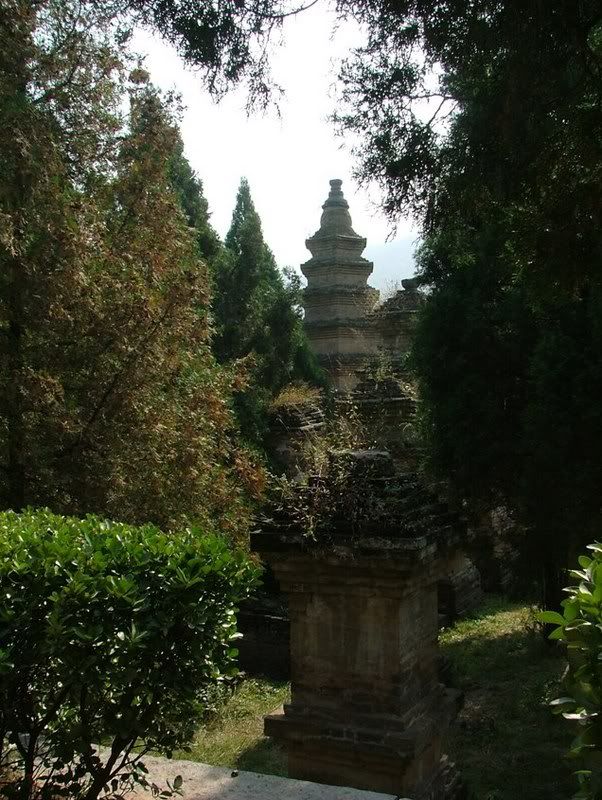
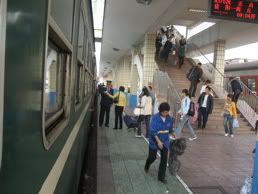
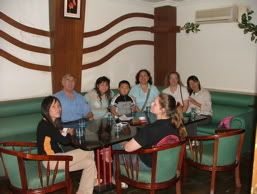







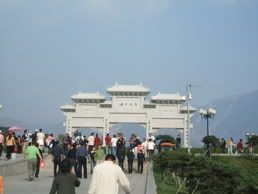

















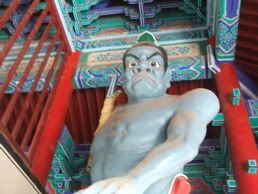




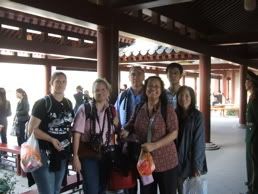
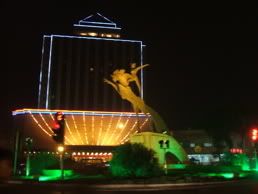





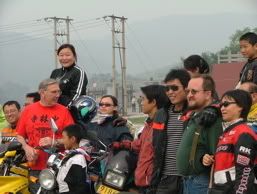


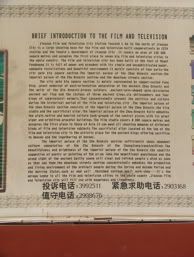












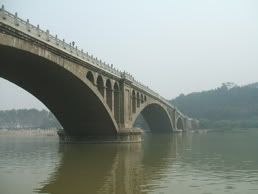










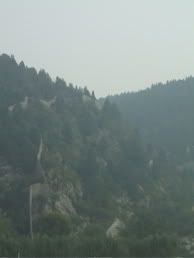
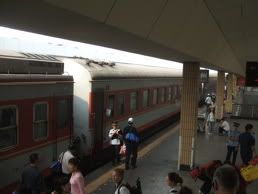
No comments:
Post a Comment